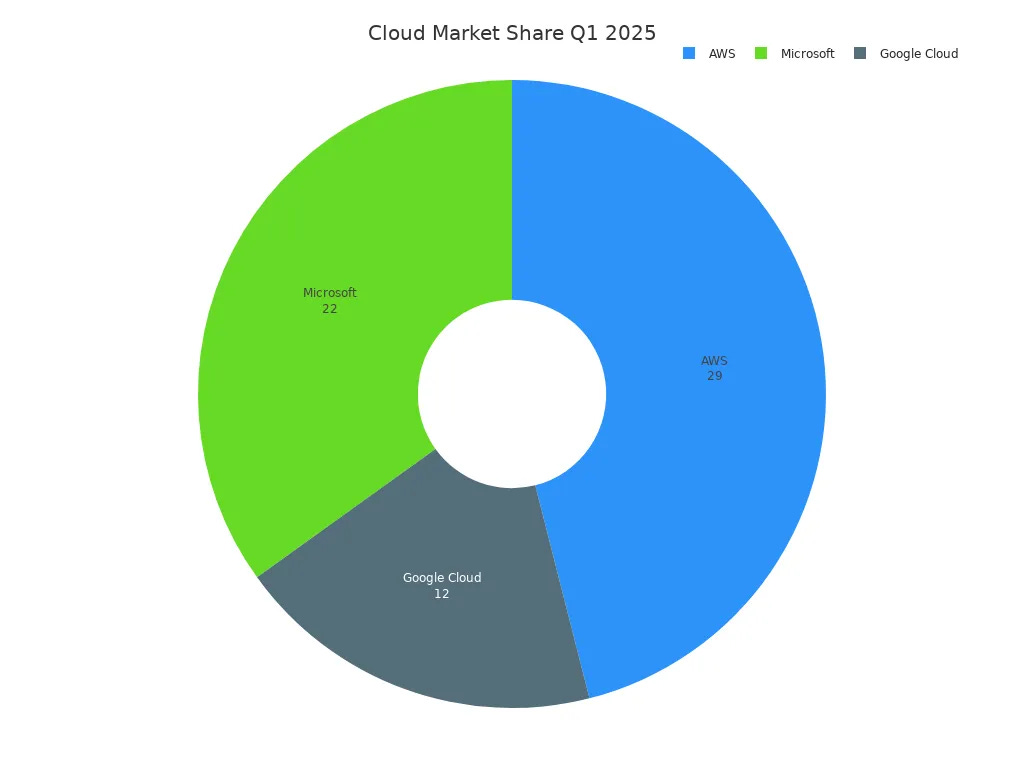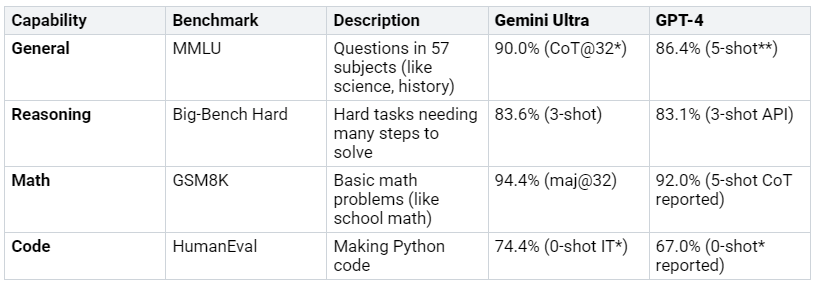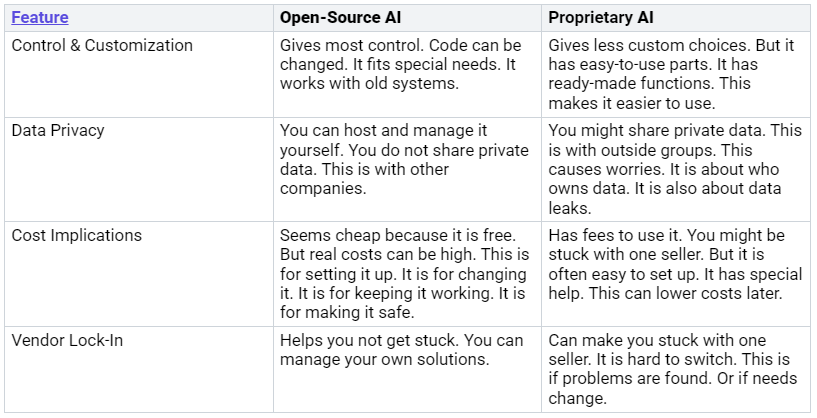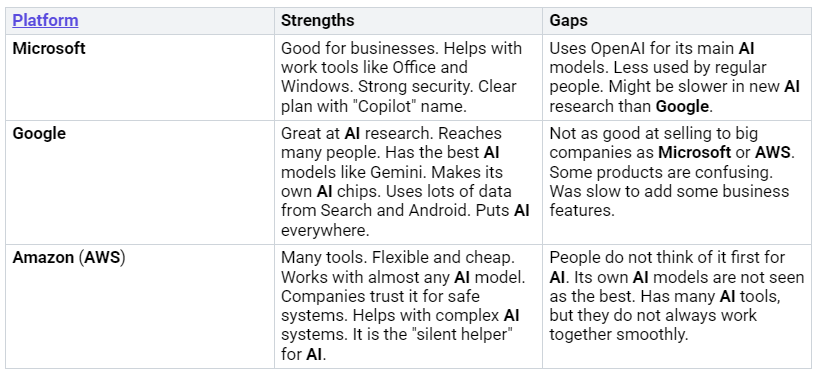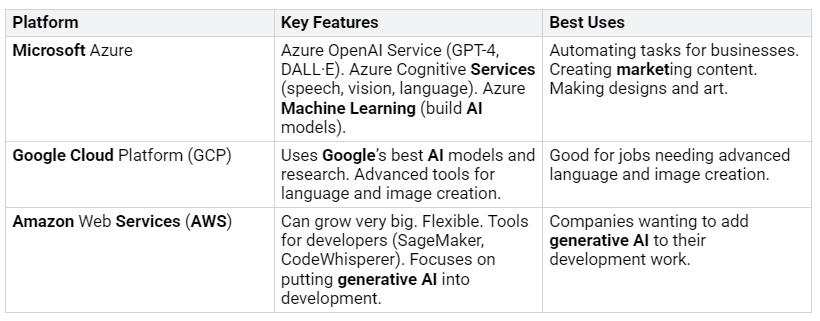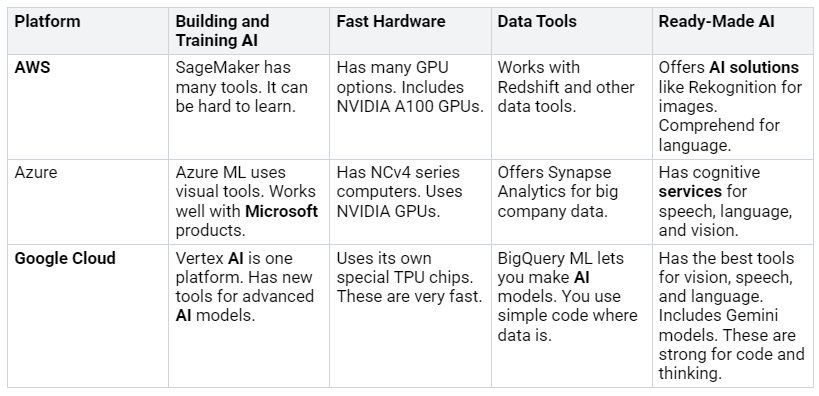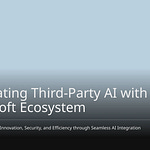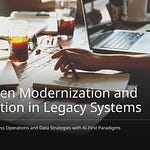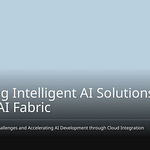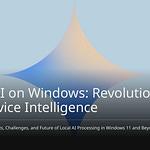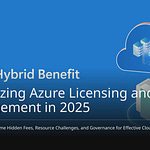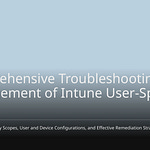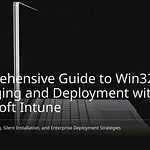Who’s leading the charge in the cloud and AI race? The answer largely hinges on effective AI strategies. While Microsoft excels in generative AI, AWS holds the strongest position in conventional AI, and Google demonstrates prowess in other AI domains.
As of Q1 2025, AWS commands 29% of the cloud market, with Microsoft at 22% and Google Cloud at 12%. However, when it comes to generative AI, Microsoft’s strategies have secured them a significant 39% market share, compared to AWS’s 19%. This blog delves into the distinct generative AI approaches of Microsoft, Google, and AWS. We’ll dissect each company’s plan, identify their core strengths, and forecast their future standing in the competitive cloud AI landscape, including their generative AI capabilities and adoption.
Key Takeaways
Microsoft is best in AI. It is also best in generative AI. This is true for businesses. It works with OpenAI. It puts AI into tools. One tool is Microsoft 365 Copilot.
AWS is very good at old AI services. It has the biggest part of the cloud market. It gives many tools to companies. These tools help them build their own AI.
Google uses an ‘AI-first’ plan. It puts good AI like Gemini models into all its cloud products. It is great at AI research. It is also great at multimodal AI.
Open-source AI helps new ideas. It makes things more competitive. Companies get more control. They also get more choices. They do not get stuck with one company.
Microsoft’s Strategies in Cloud AI
Azure Enterprise and Hybrid Cloud
Microsoft uses Azure’s strong business tools. Azure helps big companies. It has many data centers around the world. There are over 300 secure centers. They are in more than 60 places. This setup makes things always work. It is reliable for important tasks. So, 95% of big companies trust it. Azure also keeps data safe. It has ways to save data in different places. It also has built-in security. This includes protection from attacks. For mixed cloud systems, Azure Arc helps. It brings Azure services to other places. This means rules are the same everywhere. It also helps control access. It makes managing different systems easy. This helps with cloud setups. It also helps with AI connections.
OpenAI Partnership and Generative AI
The OpenAI deal is key. It is part of Microsoft’s AI plans. Microsoft put a lot of money into it. Azure is now the only cloud for OpenAI. This teamwork shapes Azure’s AI plan. It adds strong AI tools. These include GPT-3 and DALL-E-2. They are now part of Azure. This offers AI as a service. It makes advanced AI easy to use. The partnership gives business-level features. These include security and reliability. They also include following rules. This helps use new AI faster. It also makes it more profitable. This special link helps Microsoft stand out. It makes its cloud AI services different.
Microsoft 365 Copilot and Productivity
Microsoft 365 Copilot shows Microsoft’s AI focus. It helps with getting work done. This AI helper works in Microsoft 365 apps. These include Word, Excel, and Outlook. It makes work smooth. Copilot understands normal language. It can clean up data. It can summarize things. It can also make charts. It uses Microsoft Graph. This gives Copilot information. It gets it from emails and chats. It also gets it from files. This makes its help right for you. It can handle different types of information. It keeps track of what you are doing. Copilot saves time. It does repeated tasks for you. It also helps people work together. It helps make better choices. It uses smart, relevant information. These AI tools make businesses work better.
Developer Ecosystem and Open Source
Microsoft helps many developers. It also supports open source. The company helps many open-source projects. It does this through special programs. One is the Free and Open Source Software Fund. This fund lets Microsoft workers pick projects. They choose which ones get money. This helps engineers who are passionate. Microsoft’s One Engineering System uses open source. It builds it into how they work. This system uses automatic tools. Many open-source projects use GitHub Actions. They also use Azure Pipelines. Microsoft uses these a lot. This support for open source helps new ideas. It also spreads Microsoft’s AI tools. It also helps its cloud services.
Infrastructure and Edge Computing
Microsoft’s setup is strong. It supports AI tasks well. Azure has cloud tools made for AI. They are built from the ground up. They balance speed and cost. They work for many AI needs. This includes powerful virtual machines. They have fast networks. They also have quick storage. The system is safe and reliable. It has scalable groups of computers. It has security built in. It also has AI safety rules. Azure’s edge computing tools add to this. They make things work together easily. They allow fast setup. They also help AI solutions grow. These improvements are key. They support complex AI models. They also support other AI services. This makes Microsoft’s AI cloud plan strong.
Google’s AI-First Cloud Strategy
Google uses an “AI-first“ plan for its cloud business. This plan puts artificial intelligence into all its cloud products. Google Cloud has trouble getting as many customers as AWS and Azure. This is especially true with big companies. But AI helps Google Cloud grow. Google is very good at AI research and making new AI. This helps it offer great AI solutions.
Google Cloud Services
Google Cloud Platform (GCP) has many services. It has 19 different types of services. This might be the most among the top three companies. GCP is great at special services. These are for big data, machine learning, and analytics. It can handle a lot of work. It also balances the work well. Google helped create Kubernetes. So, it knows a lot about using containers. Its container service is a big plus. GCP also likes open-source and DevOps.
Google Cloud’s Compute Engine uses clean energy. It uses half the power of normal data centers. Google wants fair prices for customers. It often beats competitors’ prices. It gives big discounts. It also has flexible deals. These special things help Google get customers.
Gemini and Bard: LLM Strategy
Google’s plan for generative AI uses its Gemini models. Gemini has a special design. It is the first large language model (LLM). It learns from text, pictures, and videos all together. It uses Transformer and Mixture of Experts (MoE) designs. MoE models use smaller AI networks. These turn on based on what they get. This makes them work well. Gemini can change and grow easily. It works on many devices. These go from cloud to small devices. The Gemini family has Gemini Ultra and Pro. These are for regular computers. Gemini Nano is for small devices. Gemma offers open-source LLMs.
Gemini was made for many types of data. It can make pictures directly. Bard first used Gemini Pro. It worked with text. Other types of data were planned later. Bard uses the Gemini Pro model. This model is like GPT-3.5. The stronger Gemini Ultra model was not ready at first.
Gemini Ultra is better than GPT-4 at math and making Python code. GPT-4 is better at common sense. Gemini 1.5 Pro and Flash models can take a lot of input. They can handle one hour of video. Or they can handle 700,000 words. Gemini 2.0 Flash remembers much more. It can keep more info for longer talks. Or it can process more info at once. Gemini 2.0-Flash made the fewest mistakes. This shows it is strong in generative AI.
Vertex AI and MLOps
Vertex AI makes MLOps easier. It helps developers. It is one place for everything. This means less switching between tools. It helps businesses work better with AI. Vertex AI has many AI services.
Data Preparation: It uses Vertex AI Workbench notebooks. These are for looking at and cleaning data. It works with Google Cloud Storage and BigQuery. It handles large amounts of data. This is done with Spark jobs.
Model Training: It has many choices. AutoML trains models automatically. No code is needed. Custom training runs your code. It uses Docker containers. It works with GPU/TPU. It also tunes settings.
Model Evaluation & Iteration: It has tools to check models. It compares numbers. It improves things based on how well they work. Models are saved in the Model Registry.
Vertex AI also includes:
Model Deployment & Serving: It helps put models to use. This is for quick or batch predictions. Vertex AI manages computers.
Pipelines & Automation: It uses Vertex AI Pipelines. These organize complex tasks. They go from data prep to putting models to use. It helps with automatic retraining. It also helps with CI/CD.
Feature Store: It manages machine learning features. It does this in one place. It gives fast access. It also watches for changes in features.
Experiment Tracking & Model Registry: It has tools to follow experiments. It has a Model Registry. This keeps track of model versions. It is a main list for ML models.
Monitoring & Explainability: It has Vertex AI Model Monitoring. This finds problems. These are like data changes. It also finds differences between training and use. Vertex AI Explainable AI helps understand model predictions.
These tools help customers. They build, use, and manage AI solutions well.
Open Source Contributions
Google helps the open-source community a lot. This is a big part of its AI plan. It offers main tools and code. TensorFlow is a key tool. It builds and trains ML models. This is done on many computers. JAX is a simple system. It combines automatic math. It also uses the XLA compiler. This is for fast ML. Keras is an easy and strong ML framework. It works with TensorFlow. This is for building and training models fast. Google helped start the PyTorch Foundation. This wants to spread ML use. It does this through open-source.
Google also gives open models for generative AI. Gemma is a group of small, good open models. They come from the same research. This research made the Gemini models. You can find them on Google AI Studio. This is a website tool. It is for trying out generative models. Google’s open-source help creates new ideas. It also spreads its AI services. It also spreads its cloud uses.
Global Network and Hardware
Google’s global network is huge and strong. It supports its cloud services. It also supports its AI capabilities. This network gives fast connections. These are all over the world. It makes sure everything works well. Google makes its own special computers. These include Tensor Processing Units (TPUs). TPUs are special chips. They make machine learning tasks faster. This special hardware helps Google. It trains and uses complex AI models well. It supports its advanced generative AI products. This strong system is very important. It gives scalable AI solutions to businesses.
AWS Cloud Leadership
AWS Cloud Dominance
Amazon Web Services (AWS) leads the cloud market. It started cloud computing early. This gave it a big head start. AWS always has the most customers. In Q2 2025, AWS had 30% of the world’s cloud market. This shows it is very strong. Microsoft Azure was next with 20%. Google Cloud had 13%. This makes AWS a powerful company. The company made $30.9 billion in three months. This means it could make over $124 billion in a year. This growth is partly from AI services. These services grow very fast. AWS has strong systems. It has many services. These attract many customers. Its full AI plan helps this growth.
Amazon Bedrock and Custom Models
Amazon Bedrock is important for generative AI. It gives an easy way for developers to use AI. They can use basic AI models. They can build generative AI apps. Bedrock makes these models bigger automatically. This makes sure they work best. This happens as more people use the apps. Its serverless design helps developers. They can focus on making apps. They do not worry about computers. Bedrock uses strong Amazon security. This includes keeping data secret. It makes sure data is safe. Amazon Bedrock has many basic AI models. It has one way to use them. It also lets you change models easily. You do not need to write code. It uses a visual tool. Bedrock connects AI models to data safely. This makes generative AI useful for businesses.
SageMaker and ML Services
Amazon SageMaker helps with all machine learning (ML) work. It makes the ML process simple. SageMaker helps users get data ready. It uses Amazon SageMaker Data Wrangler. It makes XGBoost models. It uses Amazon SageMaker Training Jobs. It keeps track of tests. It uses Amazon SageMaker Experiments. SageMaker checks how good models are. It uses Amazon SageMaker Processing. It explains models. It uses Amazon SageMaker Clarify. SageMaker hosts models to use them. It does many predictions at once. It watches models for changes. Amazon SageMaker Pipelines automate everything. This is a full service for ML work. SageMaker Model Registry manages ML models. This helps people work together. It also helps with rules. This full system helps businesses use data. It offers strong AI solutions.
Open Source Adoption
AWS works a lot with open-source groups. It helps popular open-source projects. Amazon RDS offers open-source databases. These are like PostgreSQL and MySQL. Amazon Elastic Kubernetes Service (EKS) uses Kubernetes. AWS helps Kubernetes a lot. It helps many Apache Software Foundation projects. Amazon releases open-source tools. These include AWS SDKs and AWS Amplify. AWS Cloud Development Kit (CDK) is another example. AWS helps people work together. It holds events and meetings. These include open-source talks at Amazon re:Invent. AWS also supports open-source ideas. It works with companies like Red Hat. This strong help benefits all developers.
Industry Solutions
AWS offers special solutions for industries. These use AI and cloud tech. Amazon helps money companies. It gives them AI cloud tools. For factories, it makes Industry 4.0 simple. This uses safe cloud and AI ideas. In stores, Amazon helps make things personal. It uses cloud AI to manage products. SaaS and tech companies create new things. They use AI-powered SaaS and ML analysis. Amazon Bedrock makes new ideas happen faster. It helps work get done. It makes things bigger with generative AI. Amazon SageMaker makes models easy to use. It makes models personal. Amazon Kendra brings knowledge together. It is a smart search tool. These business AI offers give special tools for different areas.
Open Source: Impact on Cloud AI
Innovation Foundation
Open-source software helps AI grow a lot. It gives many useful tools. It also gives frameworks and models. This fast growth also brings problems. A report shows big open-source efforts. These are in cloud systems. Open-source tools power big jobs. They work in many cloud places. They help run AI tasks. They also help schedule and grow them. They support different ways to store data. This is for AI apps. Open-source AI models as a service help with ModelOps. This is for making cloud models. It includes getting data ready. It also includes making AI models. Open-source AI app making makes RAG easier. It also makes AI agent making easier. It is key for businesses to use AI. Open-source AI rules give safety checks. These are for the AI supply chain. Open-source AI groups help new ideas. Groups like the Cloud Native Computing Foundation focus on AI.
Competitive Threat
Open-source AI models are a threat. They compete with paid cloud AI services. They have different good and bad points.
Open-source AI gives the most control. Users can change code. They can make it fit perfectly. This is different from paid options. They offer less custom choices. Data privacy is another big difference. Open-source lets you keep data inside. You do not share private data. Paid AI might share data. This is with outside groups. Open-source seems cheap. But setting it up and keeping it working costs a lot. Paid AI has fees. But it is easier to set up. Open-source helps avoid being stuck. Paid options can make you stuck.
Integration Strategies
Companies use different ways. They bring in open-source tools. They often use open-source frameworks. They also use open-source tools. This lets them build special AI solutions. Smart integration helps businesses. They use new ideas from the community. This also stops them from being stuck with one seller. Many groups want to add open-source parts. They put them into their cloud systems. This way gives them freedom. It also saves money.
Proprietary vs. Community
The choice depends on what you need. It is between paid and community AI. Paid systems offer special help. They are often easier to use. Community open-source options give more freedom. They are also more clear. They help people work together. Businesses think about these things. They look at control and data privacy. They also look at long-term costs. This is for their AI plans.
The Cloud AI Race: Who is Ahead
The cloud AI race is a tough fight. Top cloud AI providers are in it. Each company has its own plans. These plans decide their place in the market.
How Companies Use AI
Microsoft is great at helping big companies. It has strong links with its customers. This gives it a big lead. Microsoft 365 Copilot adds generative AI to daily tools. This makes AI easy to use. Azure Arc brings Microsoft‘s cloud services to other systems. This makes things work the same everywhere. This helps big companies use AI. It does not mess up their work.
Google uses an “AI-first“ plan. It puts AI deep into its cloud tools. Vertex AI is one place for machine learning. It makes building AI solutions simple. Google helps companies that use a lot of data. It offers great analytics and AI tools.
Amazon Web Services (AWS) has many tools. It lets companies build their own AI solutions. Amazon Bedrock and SageMaker let customers pick generative AI models. They can also make their own. AWS is a good partner for companies using AI.
What Each Company Does Best in Generative AI
Each company has special strengths in generative AI.
Microsoft will likely lead in AI for business work. It has many software products. It was quick to add AI helpers like Copilot. These are in Windows, Office, Azure, and GitHub.
Google will likely lead in AI for everyday people. It will also lead in AI systems that work across many devices. It uses its vast knowledge. It uses personal data. It uses AI that understands many things like pictures and sound. This makes smart helpers.
Amazon (AWS) is the “silent helper” for AI. It lets companies build their own AI solutions. It offers many AI models and tools. It focuses on being neutral and flexible.
How Easy It Is for Developers
How easy it is to build AI varies.
Azure AI Agents are best for companies already using Microsoft. They offer good chat AI. They connect easily to other tools. They meet business rules.
AWS AI Agents are good for developers using AWS. They focus on chat AI. They connect well with other Amazon tools.
Vertex AI Agent Builder is great for GCP users. It has advanced generative AI. It lets you build with little code. It connects well with other GCP services. This helps make smart helpers.
How Big the System Is
How big the system is matters a lot.
Amazon Web Services (AWS) started in 2006. It is the oldest cloud platform. It is used the most. It has the biggest market share. It serves millions worldwide. Microsoft Azure started in 2010. It quickly became popular. This was true for companies using Microsoft products. It works well with Windows Server and Office 365. Google Cloud Platform (GCP) started in 2008. It is known for data tools. It is also known for machine learning and AI. It grows steadily. This is among companies that use a lot of data. It is behind AWS and Azure in market share.
How Much It Costs
Prices affect what customers choose. Amazon (AWS) lets you pay for what you use. This helps customers save money. They only pay for what they need. It also has discounts for long-term use. Google Cloud often has lower prices. It gives automatic discounts for long use. It also has custom computer types. This can save money for certain jobs. Microsoft Azure has flexible prices. It has options for reserved use. It also has benefits for using existing Microsoft licenses. Big companies often like Microsoft‘s packages. These combine cloud computing, software, and generative AI. Each company tries to have good prices. They also want to offer value for their AI and cloud tools.
Future Cloud AI Trends
Edge AI and Distributed Computing
Edge AI is growing fast. Gartner thinks generative AI will be in 60% of edge computing by 2029. This is a big jump from 5% in 2023. This means AI will be closer to data. This helps with big data. It also makes decisions faster. WebAssembly (WASM) is key for edge apps. Google Cloud and Fastly use it. It makes apps work well. The U.S. government likes WASM for cloud safety. Generative AI changes edge plans. It uses semantic caching. This makes things faster. It also helps customers. Cloud and edge AI together are good. They give more power for AI. They also make things faster. They save internet use and money. Soon, AI models will work better at the edge. Hybrid AI will share tasks.
Sovereign Cloud and Data
Sovereign cloud and data rules are hard for AI providers. Providers must change how they handle data. They must follow these rules. They need to put AI in the right places. They also need to check data for privacy risks. Companies cannot just trust cloud providers. They need to know where their data is. Many countries are making their own clouds. This makes data storage harder. Cloud providers must be clear. They must show where data is stored. They must show how it moves. “Sovereign AI” means countries control AI. This makes it hard for outside AI systems. More data laws will come. Breaking them can cost a lot of money.
Ethical AI Development
Making AI fairly is very important. Companies must make AI fair. It must be easy to understand. They need to make AI responsible. This stops unfairness and bad use. Good rules make AI help everyone. They also keep people’s rights safe.
Talent and Research
The cloud AI world needs more skilled people. C1 CIO Viral Tripathi says we need new kinds of talent. These people must manage AI. Johar says many more AI solutions are needed. Cybersecurity and AI are top training needs. Over one-third of people agree. CompTIA says two-thirds of companies will train staff. This is for IT skills like security and data. The O’Reilly 2024 survey shows a big AI security skill gap. 33.9% of tech workers see this problem. Prompt injection is a worry. Cloud security skills are also missing. AI security tools are a top research goal.
Microsoft aims its plans at big businesses. It leads in all AI and GenAI. This is through its OpenAI deal. Microsoft puts generative AI into work tools. This makes its cloud better. This GenAI focus makes Microsoft special. Google pushes an AI-first cloud plan. It is great at research. It also excels at multimodal AI with Gemini. Its generative AI is strong. Amazon’s AWS keeps its top cloud setup. AWS gives flexible AI services. This makes Amazon a leader in old AI. Amazon’s large market helps many AI tasks. Amazon gives strong tools for big companies. Amazon’s drive to invent powers its AI. Amazon keeps shaping the cloud AI race. No one company is too far ahead. The generative AI market changes fast. Working with others and open-source will decide who wins. The future of AI and cloud will see these big companies always changing technology.
FAQ
Who is the top company in all AI and Generative AI?
Microsoft is the leader. This is for all AI and Generative AI. Its work with OpenAI helps. It also puts AI into Microsoft 365 Copilot. This makes it a leader. Microsoft’s plans help big businesses. They also make work better.
Which cloud company is strongest in regular AI?
AWS is strongest in regular AI. It started cloud computing early. This gave it a big lead. AWS has many AI services. These include Amazon SageMaker and Bedrock. They help many customers.
What is Google’s main plan for cloud AI?
Google uses an “AI-first” plan. This is for its cloud AI. It adds good AI tools. These are like Gemini models and Vertex AI. They are in all its cloud products. Google uses its research power. This helps it offer new AI solutions.
How does open source affect cloud AI competition?
Open source really changes cloud AI. It helps new ideas grow. It also creates competition. It gives basic tools and models. This helps things develop fast. Companies need to use open-source tools wisely. This helps them stay competitive. It also stops them from being stuck with one seller.


